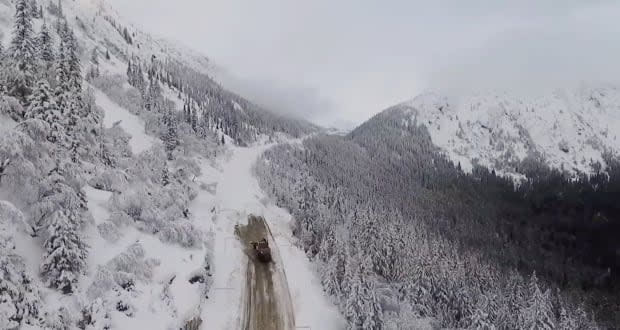Snowbombing and digging: Crews in Yukon still working to clear the South Klondike Highway
The South Klondike Highway south of Carcross, Yukon, is still deemed impassable Friday morning after a series of avalanches earlier this week.
A map on the 511 Yukon road report shows the closure extends from Carcross and south beyond the Yukon border.
While crews have been working away to clear the road, Greg Eikland, western area supervisor with the Department of Highways and Public Works, says there's still a lot more snow to be dealt with as of Thursday before it can reopen.
He says the avalanches are rated about a three on a one-to-five scale and can be around 15 feet high and between 40 to 100 feet wide.
"A size three is [like] a very small car," he said adding it could take out a smaller building and bring down trees with it.
So far, he says since there isn't any reported damage, though sometimes avalanches can cause problems for the guard rails on the road. Right now, crews are still working on digging through the snow.
"We just target areas that are frequent avalanche zones," Eikland said.
He explained that if the avalanches don't come down, when they should or if there is a lot of snow storage, such as large overhangs, then they'll do controlled snowbombing.
"We'll actually close the road, bomb them and deal with snow that way," he said. "One particular [avalanche] that is a pretty active one, it didn't come down, so [we] threw some charges on that and brought it down."
"So that just adds to the amount of work that we have to get everything cleaned up so we can open this road back up."

More avalanches than usual
Eikland says there can be up to about eight people working on the snow clearing. While the avalanches are only a little bigger that usual, he says it's an exceptional year in terms of how often they're tumbling.
"It's just the frequency of them — they're coming down quite a bit," he said. "It's a good winter for snow for sure."
He says, despite the border to Alaska being closed to all non-essential travel, it's still important that the highway is passable for fuel trucks and other traffic needing to get through.
"We try and get a hole punched through so at least if we have to move some traffic for emergencies or what not we can all get them out," Eikland said.
"Hopefully we can get that out as soon as we can … just keep keep plugging away at these avalanches and then we should be ready to open."
It's hard to predict when the highway might open, but Eikland said on Thursday that the highway could open Friday afternoon or sometime on Saturday.
'Avalanches still possible out there'
James Minifie, lead avalanche field technician for Avalanche Canada in Yukon, said Friday morning that people should stay aware of the fact that big storms have been creating sizeable avalanches.
"People should continue to look for that pattern of storms coming, you know avalanche danger goes up during and shortly after the storm, and then kind of slowly comes down over the next few days."
He said if people are heading out into inland areas they should build time into their day to account for varying conditions.
"You might get surprised by avalanches in places that you wouldn't expect them, so, you know, really taking time to think hard about your route and using terrain wisely to ... reach your objective."
"Avalanches are still possible out there, even though we've come into the moderate danger rating. You know just really thinking about the steepness of the slope," he said.
He said people should also be aware of the quality of the snow, listen for "whompf" sounds, and watch for cracks.
He said people in Yukon can get information on the Yukon avalanche website or the Avalanche Canada website. People should also post to the Mountain Information Network so they can track inland snow conditions.

 Yahoo Finance
Yahoo Finance 